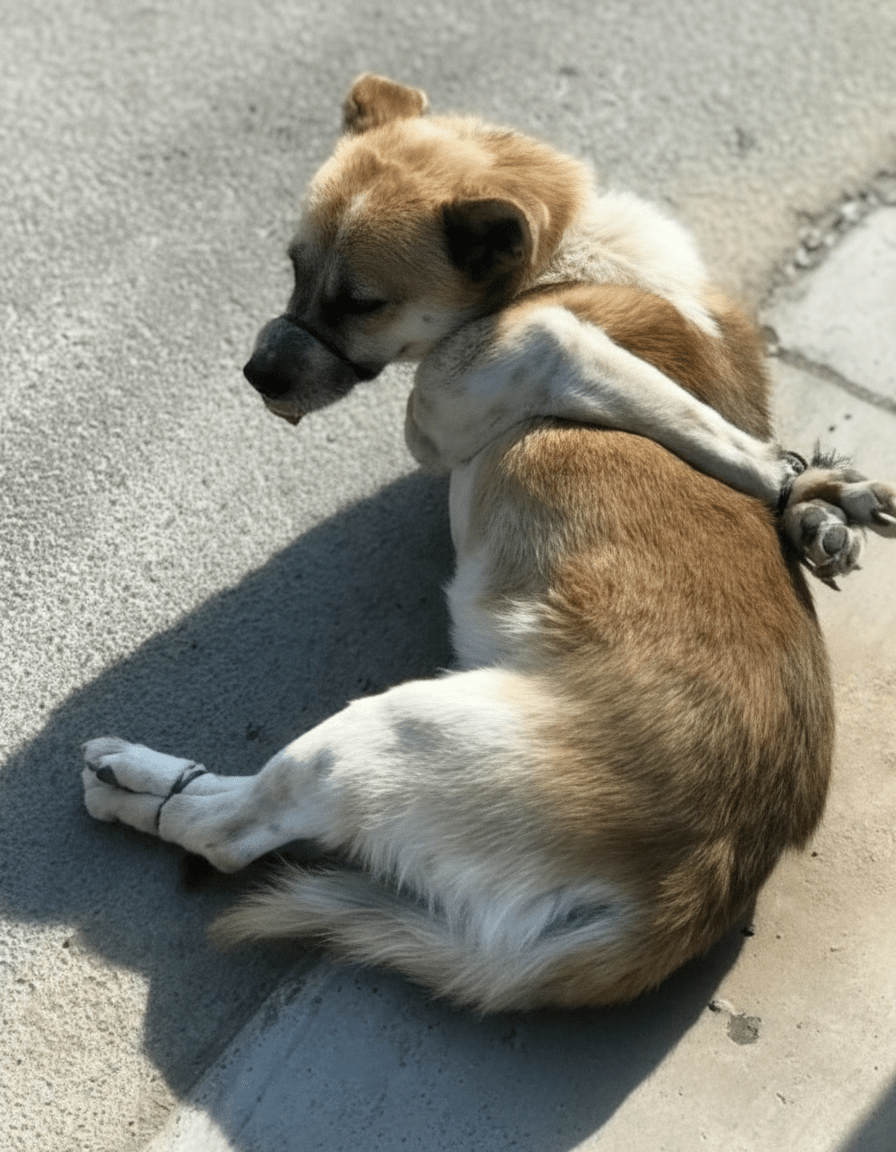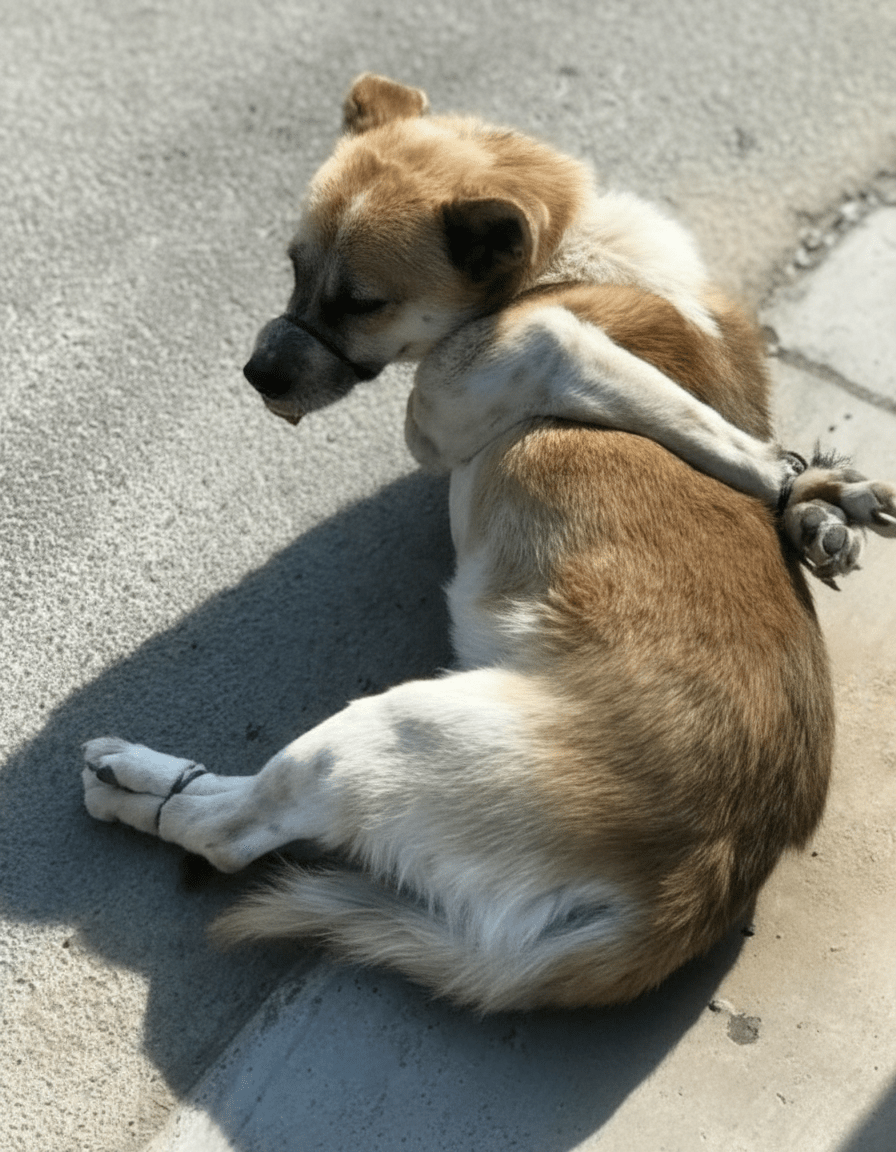In the heart of a sun-baked market square in Marrakech, Morocco, where the air thrummed with the calls of spice vendors and the clatter of brass trays, a small brown-and-white dog lay motionless inside a rusted metal cart typically reserved for lamb carcasses. The cart, parked haphazardly beside a butcher’s stall, had become an impromptu prison. The dog’s legs were bound with coarse twine, his muzzle sealed shut with silver duct tape that glinted cruelly under the North African sun. His eyes—wide, glassy, and rimmed with the red of exhaustion—were the only part of him that could still move, darting frantically from face to face in the passing crowd. Tourists haggled over saffron; locals balanced baskets of mint and oranges on their heads; children chased a stray soccer ball. Yet no one stopped. For nearly three hours, the dog remained a silent exhibit of suffering, his chest rising and falling in shallow, panicked breaths. This was not a fleeting moment of oversight but a chilling tableau that would soon ignite international fury, revealing a hidden trade in live animals smuggled through open-air markets from Marrakech to Mexico City, Bangkok to Bogotá.

The discovery came at 11:47 a.m. on a Tuesday in late October, when a British expatriate named Clara Henshaw, a veterinarian volunteering with a local stray rescue, noticed the cart while buying olives. What caught her eye was not the dog’s body—curled tightly to conserve what little space the cart allowed—but the unnatural stillness of his snout. A strip of tape had been wrapped so tightly that the skin beneath had begun to swell, turning a sickly purple. Henshaw dropped her shopping bag, olives scattering across the dusty cobblestones, and approached the cart. The butcher, a wiry man in a blood-stained apron, waved her off with a dismissive flick of his cleaver. “Not for sale,” he muttered in Darija, assuming she wanted to buy meat. Only when Henshaw peeled back a corner of the tape did the dog emit a sound—a thin, whistling wheeze that carried the weight of hours spent suffocating in silence.
What unfolded next was a chain of events as improbable as it was harrowing. Henshaw’s frantic calls to local police were met with shrugs; animal cruelty, while technically illegal in Morocco, rarely disrupted the rhythm of market life. Undeterred, she live-streamed the scene on Instagram, tagging global animal rights groups. Within minutes, the video ricocheted across continents. In São Paulo, Brazil, a similar cart had been intercepted just forty-eight hours earlier—same rusted design, same twine bindings, but with a crucial difference: the dog inside had been destined for a clandestine dog-meat restaurant in the city’s Japantown district. Brazilian authorities, tipped off by Henshaw’s stream, raided the premises and found refrigeration units stocked with dozens of carcasses, each bearing the same distinctive tape marks.
The connection was not coincidental. Forensic veterinarians in Marrakech, working alongside Interpol’s wildlife crime unit, uncovered a smuggling ring that operated like a macabre franchise. Dogs—mostly strays rounded up from rural villages—were sedated with a cheap veterinary tranquilizer, bound, and loaded into meat carts to bypass agricultural checkpoints. The carts, indistinguishable from those used for halal slaughter, were then shipped via ferry and truck across three continents. In Thailand, a raid in Bangkok’s Chatuchak Market revealed a cart hidden beneath tarpaulin, containing not one but two dogs stacked atop each other, their bodies pressed so tightly that the lower animal’s ribs had fractured under the weight. The upper dog, a floppy-eared mutt with a missing ear, was still alive—barely—his tongue protruding grotesquely where the tape had slipped.
Perhaps the most bizarre detail emerged from a whistleblower in Colombia. In the port city of Cartagena, customs officials had grown suspicious of a shipment labeled “goat parts” that arrived from Panama. X-rays revealed a hollowed-out compartment within the cart itself—a false bottom where a live dog had been concealed for the 14-hour journey. The animal, a brindle-coated female later named Esperanza by rescuers, had survived by licking condensation from the cart’s metal walls. Her paws were raw from scratching at the steel, leaving bloody streaks that forensics later matched to the Marrakech dog’s bindings. DNA analysis confirmed a grim truth: the twine used in Morocco, Brazil, Thailand, and Colombia was manufactured by a single supplier in Shenzhen, China—a company that also produced fishing nets and cargo straps.
Public reaction was swift and visceral. In London, protesters gathered outside the Moroccan embassy, holding enlarged photos of the dog’s taped muzzle. The image—dubbed “The Silent Plea” by media outlets—became a viral symbol, surpassing 50 million views in 72 hours. Celebrities amplified the cause: a K-pop star in Seoul donated $100,000 to fund rescue operations, while a Bollywood actress live-tweeted her adoption of a Thai rescue dog, challenging fans to match her pledge. Yet beneath the outrage lay darker revelations. In Mexico City’s Mercado de la Merced, undercover journalists posing as buyers were offered “fresh cart dogs” for 300 pesos—less than the cost of a decent steak. The seller, a teenager with a smartphone and a switchblade, boasted that the animals were “pre-tenderized” by the journey.
Back in Marrakech, the original dog—now named Samir by Henshaw’s team—underwent emergency surgery to repair a fractured jaw sustained when the tape was removed too hastily. Veterinarians discovered something extraordinary: a microchip implanted beneath his skin, registered to a shelter in Lisbon, Portugal. Samir had vanished from a beachside promenade two years earlier, likely snatched during a evening walk. His journey had taken him across the Strait of Gibraltar, through Spain’s underground dog-fighting rings, and finally to Morocco’s meat markets. The microchip’s GPS data, corrupted but partially recoverable, painted a zigzag route that matched known smuggling corridors.
The scandal forced governments to act. Morocco’s King Mohammed VI issued a rare public statement condemning the trade, pledging $2 million for animal welfare enforcement. Thailand banned the use of metal carts for live transport within 48 hours. Brazil’s federal police arrested 27 suspects, seizing 14 carts and liberating 19 dogs—three of whom were pregnant. In a poetic twist, one of the rescued Thai dogs gave birth in a São Paulo shelter to a litter of six puppies, each with a distinctive white patch over one eye—identical to Samir’s marking. Geneticists theorized a shared ancestry, possibly from a single village in the Atlas Mountains where strays were first targeted.

Yet the story’s most unexpected chapter unfolded in the digital realm. Hackers claiming affiliation with Anonymous breached the Shenzhen supplier’s servers, leaking invoices that traced the twine to a shell company in Dubai. The paper trail led to a surprising culprit: a European pet food conglomerate that had outsourced packaging materials to cut costs. The company’s “hypoallergenic kibble” bags, sold in upscale pet stores from Paris to Los Angeles, were sealed with the same twine used to bind the dogs. Consumers revolted, boycotting the brand and flooding its social media with photos of the taped muzzles. Stock prices plummeted 18% in a single day.
Samir’s recovery became a beacon of hope. After weeks in a Marrakech clinic, he learned to trust again, wagging his tail tentatively at the sound of Henshaw’s voice. She adopted him, relocating to a quiet farm outside Casablanca where he now chases chickens and sleeps beneath a fig tree. His story inspired a global initiative: the “Cart Watch” app, launched by a Silicon Valley startup, allows users to report suspicious meat carts in real-time, using AI to cross-reference images with a database of known smuggling designs. In its first month, the app flagged 87 incidents across 12 countries, leading to 41 rescues.
The world had looked away once. It would not do so again. From the souks of Marrakech to the mercados of Mexico, the silent plea of a single dog had exposed a hidden artery of cruelty—and, against all odds, stanched its flow. Samir’s eyes, once pleading in a cart of death, now sparkle under a Moroccan sunset, a living testament to the power of one voice amplified by millions.






